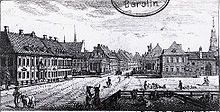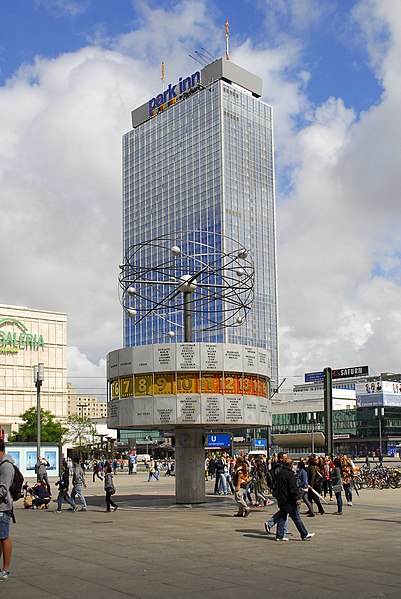有人頂著傘Grill Walker賣每個1.35歐元的德國"熱狗. 一天要賣200個.
附近也有一家 Meissen磁器店有許多繁花瓷器 據說他們式樣已上萬種.
第二道中庭春天種花 .
街道旁木之圖書館....
圍牆上的舊共產國產車 羊毛與合成樹脂
有薪男性育嬰假
三代相傳的拖鞋製造商.
果漿和空心麵包Zinger
免費的愛樂: 布拉姆斯的雨夜小提琴.

Meissen hard porcelain vase, circa 1730. Indianische Blume ("Flowers of the Indies") in imitation of the Kakiemon style of Arita porcelain, Japan. Musée des Arts Décoratifs, Paris.
Alexanderplatz
From Wikipedia, the free encyclopedia

Neighborhoods in Berlin-Mitte: Old Cölln [1] (with Museum Island [1a], Fisher Island [1b]), Altberlin [2] (with Nikolaiviertel [2a]), Friedrichswerder [3], Neukölln am Wasser [4], Dorotheenstadt [5], Friedrichstadt [6], Luisenstadt [7], Stralauer Vorstadt (with Königsstadt) [8], Alexanderplatz Area (Königsstadt and Altberlin) [9], Spandauer Vorstadt [10] (with Scheunenviertel [10a]), Friedrich-Wilhelm-Stadt [11], Oranienburger Vorstadt [12], Rosenthaler Vorstadt [13]
Contents |
History
Early history
Originally a cattle market outside the city fortifications, it was named in honor of a visit of the Russian Emperor Alexander I to Berlin on 25 October 1805 by order of King Frederick William III of Prussia. The square gained a prominent role in the late 19th century with the construction of the Stadtbahn station of the same name and a nearby market hall, followed by the opening of a department store of Hermann Tietz in 1904, becoming a major commercial centre. The U-Bahn station of the present-day U2 line opened on 1 July 1913.Its heyday was in the 1920s, when together with Potsdamer Platz it was at the heart of Berlin's nightlife, inspiring the 1929 novel Berlin Alexanderplatz (see 1920s Berlin) and the two films based thereon, Piel Jutzi's 1931 film and Rainer Werner Fassbinder's 15½ hour second adaptation, released in 1980. About 1920 the city's authorities started a rearrangement of the increasing traffic flows laying out a roundabout, accompanied by two buildings along the Stadtbahn viaduct, Alexanderhaus and Berolinahaus finished in 1932 according to plans designed by Peter Behrens.
East Germany
Alexanderplatz has been subject to redevelopment several times in its history, most recently during the 1960s, when it was turned into a pedestrian zone and enlarged as part of the German Democratic Republic's redevelopment of the city centre. It is surrounded by several notable structures including the Fernsehturm (TV Tower), the second tallest structure in Europe.Alex also accommodates the Park Inn Berlin and the World Time Clock, a continually rotating installation that shows the time throughout the globe, and Hermann Henselmann's Haus des Lehrers. During the Peaceful Revolution of 1989, the Alexanderplatz demonstration on 4 November was the largest demonstration in the history of East Germany.
After German reunification
Since German reunification, Alexanderplatz has undergone a gradual process of change with many of the surrounding buildings being renovated. Despite the reconstruction of the tram line crossing, it has retained its socialist character, including the much-graffitied "Fountain of Friendship between Peoples" (Brunnen der Völkerfreundschaft), a popular venue.In 1993 plans for a major redevelopment including the construction of several skyscrapers were published, but due to a lack of demand it is unlikely these will be constructed. However, beginning with the reconstruction of the Kaufhof department store in 2004, and the biggest underground railway station of Berlin, some buildings will be redesigned and new structures built on the square's south-eastern side. The Alexa shopping mall, with approximately 180 stores opened nearby during 2007 and a large Saturn electronic store was built and is open on Alexanderplatz since 2008.
Many historic buildings are located in the vicinity of Alexanderplatz. The traditional seat of city government, the Rotes Rathaus, or Red City Hall, is located nearby, as was the former East German parliament building, the Palast der Republik, demolition of which began in February 2006 and has been completed. The reconstruction of the Baroque Stadtschloss near Alexanderplatz has been in planning for several years.[1]
Alexanderplatz is also the name of the S-Bahn and U-Bahn stations there.
Future Development
Future plans include the demolition of the 410 ft. high former Hotel Stadt Berlin (today: Hotel Park-Inn), as well as the construction of three tower buildings. As the hotel was refurbished in 2005 and was remodeled with a new facade and has a very good occupancy rate, it is not decided if and when the plans will be implemented.
The deadline (2013) set by the state of Berlin and the investors for the completion of the 492 ft. high towers, seems to have been given up. The state of Berlin announced it wouldn’t follow through with the corresponding urban development contracts. Ten out of thirteen originally planned buildings remained after modifications. For eight of them a building lease already exists. Since 2007, the investors of the shopping center Alexa have announced several times their willingness to sell their property to another investor supervising the construction of the tower. Unfortunately, no other investor has been found so far. Hines, investor of die mitte, has developed further construction plans. Since 2009, the new construction of a 492 ft. high tower right behind the mall has been announced. On September 12, 2011 a slightly changed zoning map was presented providing an apartment tower with 400 apartments. Whether this plan will be executed or not and when this might happen is still not decided.
The World clock and Park Inn
The 37-floor high-rise is in the northeast of Alexanderplatz in the central Mitte district and has a height of 125 meters (410 feet).
注意Park Inn 上頭的吊車它是用來將人從屋頂吊滑下用--兩旁有導軌





沒有留言:
張貼留言